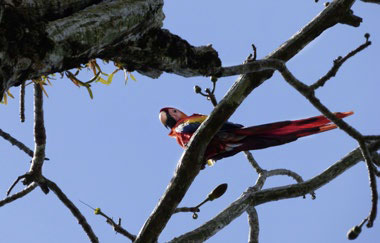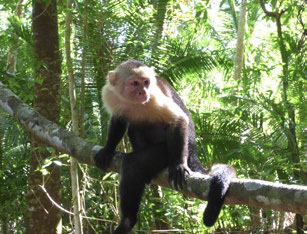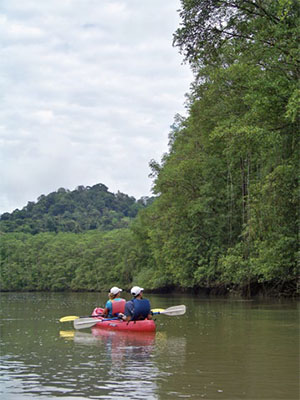IN HOW MANY PLACES can you see wild monkeys and tropical birds on a walk from your room to the dining area? On how many hikes can you spot a sloth and a blue morpho butterfly before your first sip of water? In the wildlife-packed Osa Peninsula region of Costa Rica, the animals in a square kilometer can outnumber the tourists visiting the entire region.
Costa Rica has a well-deserved reputation as the greenest country in the Americas. Around 28 percent of the small country’s land has been designated a park or nature reserve. The country with no army is one of the most biodiverse areas of the planet. It’s difficult to even get a handle on the number of species, but best guesses put it at around 850 species of birds, some 400 species of reptiles and amphibians, and about 230 types of mammals. Then there are the plants, with more than 1,000 types of orchids alone.
It’s not unusual for someone with deep pockets to buy hundreds of acres of land in this country just to ensure it stays off-limits to developers. That’s the case in the Osa Peninsula, where the large Corcovada National Park is joined by 20 other protected areas — some privately owned, some public — to make up the extensive Osa Conservation Area.

A scarlet macaw in a tree © TIM LEFFEL
One of those protected reserves flanks Lapa Rios Lodge, where my family stayed on a nature vacation. After our prop plane flight south from the capital of San José, we landed at the small Puerto Jiménez Airport and boarded a Land Rover for our ride to the lodge. On the way, our driver pulled up to a tree so we could see the dozen scarlet macaws flapping their wings and squawking there. This seemed like a good omen, since the place we were headed was named after “scarlet rivers” in the sky — lapa is the local word for the red tropical bird and rio means river. Before we even made our way to our room after arrival, we spotted agoutis on a path, a huge toucan on a branch and a few howler monkeys moving through the trees.
Lapa Rios sits on 1,000 acres of pristine wilderness extending from the deep jungle down to the sea, with only a tiny fraction of it devoted to the 17-bungalow lodge. Established in 1993, it aims to serve as an eco-friendly vacation spot that brings visitors close to nature in wild Costa Rica. Guests see plenty of wildlife and explore the forests with the hope they develop an appreciation for preserving what’s left of Central America’s biodiversity. While on our day hikes we saw a wet sloth in a tree, capuchin monkeys, aracaris, toucans and a coral snake. At certain times of year, whales breach just off the end of the peninsula and in the gulf.

A capuchin monkey © TIM LEFFEL
Down on the beach, our daughter got to experience both the good side of nature and the bad. She had fun corralling the hermit crabs and building obstacles for them to crawl over but then returned to the lodge bawling after getting stung in the water by a jellyfish.
The protected land areas of the Osa region, which straddle the deep Golfo Dulce, remain a wildlife haven thanks to the extensive connected land mass providing corridors for movement. It’s large enough for even the biggest of the big cats to roam. While visitors are not likely to spot a king of the jungle out on a casual hike, this is the only place in the hemisphere that supports all five species of endemic big cats: margay, ocelot, jaguarund, puma and jaguar. The Osa Conservation group set up camera traps in 20 different locations to get a sense of numbers and track movement.
We did keep our eyes peeled on the night hike after grabbing boots and a flashlight, hoping to defy the odds. Instead, we spotted parrots with their eyes closed, sleeping while still standing upright on branches. We saw colorful spotted frogs in the leaf cover and, occasionally, a small, slithering snake.
Feeling drawn back to the area, I returned twice more to the Osa Peninsula on other trips. While parts of Costa Rica seem like well-oiled vacation machines putting visitors through an assembly line, this area still feels wild, alive, out of control — in a good way. “We have to really lock the food and drinks up well,” the manager told me at the nine-room Playa Nicuesa Rainforest Lodge. “There are monkeys and wild pigs in these woods that we don’t want visiting camp because they can find easy handouts.” The 165 acres of their own and the Piedras Blancas National Park beyond that provide plenty of habitat for critters looking for a meal.
When I went for a walk in the forest near Playa Nicuesa, I saw squirrel monkeys rustling in the trees and lizards fornicating beside the path. Hearing strange animal noises in the distance, I followed a path in the direction they seemed to be coming from. The otherworldly sounds were unnerving, so I crept slowly to avoid being seen. Once I got there, I breathed a sigh of relief. It was a pack of peccaries arguing over the food they found.
The vacation experience at these nature lodges is comfortable but more sustainable than at most regular hotels, even in progressive Costa Rica. There are no plastic water bottles or TVs, and most of the energy comes from wind, solar or hydro sources. Candles and low-wattage bulbs are the norm. Much of the food is grown on site or bought from local producers. Common snacks are chips made from cassava, plantain or another local plant that can be sliced and fried.

A kayaking excursion © TIM LEFFEL
All the resorts in the region are self-contained since they can only be reached by boat or fourwheel drive. Rates usually include all meals at a single restaurant, served at set times. Expect a lot of fresh, locally sourced food served with care.
I also traveled to Playa Cativo Lodge, reached by boat from Golfito. Fronting a calm bay with views of the Osa Peninsula from some of the rooms, this resort features a swimming pool and one of the best restaurants in the region. I spotted wild pigs here as well, plus a golden-naped woodpecker and a long list of tropical birds. When I took a stand-up paddleboard out for a leisurely trip along the shore, two dolphins swam by, and a sea turtle poked his head up to check me out.
On my last trip to the region, I saw the Osa Peninsula by both land and sea. On an UnCruise small-ship tour along the coasts of Panama and Costa Rica, the itinerary included two nights and days around the Gulfo Dulce and the peninsula. We visited the House of Orchids botanical garden to see hundreds of plants and visiting birds, then paddleboarded up a mangrove-lined river to find rays visible below the water. At a landing on the far side of the peninsula, we went for a hike to a secluded creek for a swim and passed sandy beaches with no resorts or houses. They remain in a natural state, waiting for the sea turtles who come to lay their eggs each year.
In the afternoon after we set up on one of these deserted beaches, I went for a hike along the shore to see what I could find. Eventually I headed toward a tree hosting a noisy commotion. I looked up to find a pair of scarlet macaws, tying my first trip to the last in this region teeming with wildlife.
Costa Rica Info to Go
Two small airports, at Puerto Jiménez (PJM) and Golfito (GLF), serve domestic prop plane flights from San José (SJO). Golfito can also be reached by road from Costa Rica or Panama.
Where to Stay in Costa Rica
LAPA RIOS LODGE The original upscale jungle lodge of the region with a pool, beach, bar and restaurant. Cabo Matapalo, Puerto Jiménez $$$$$
PLAYA CATIVO LODGE This full-service eco-resort boasts attentive service, 180-degree gulf views and miles of trails to explore. Golfo Dulce $$$$$
PLAYA NICUESA RAINFOREST LODGE Reached by boat and surrounded by mountainous forest, this is one of the greenest lodges in Costa Rica. Punta Nicuesa $$$$
Restaurants in Costa Rica
EL GAVILÁN RESTAURANT Enjoy a gourmet farm-to-table dining experience during a stay at the luxury Playa Cativo Lodge. Fresh, organic produce is harvested daily from the on-site farm. Accessible only by boat. Playa Cativo Lodge, Golfo Dulce $$$
MARISQUERIA CORCOVADO This is the top seafood restaurant in Puerto Jiménez if you’re looking for a spot after landing or before departure; it offers a water view. Oceandrive Blvd., Puerto Jiménez $$$
MAR Y LUNA GOLFITO Enjoy large portions of seafood and ceviche with good cocktails on the water in the port town of Golfito. Road 14, Golfito $$–$$$
Read This Next
Beauty and Adventure in Patagonia
April 2019
Apr 1, 2019All Reads on This Topic
Read Them All

Introducing
FX Excursions
FX Excursions offers the chance for once-in-a-lifetime experiences in destinations around the world.
#globility
Insta FeedDaily
May 2, 2025French Château Hotel, Tour Brand Launch Riviera French Immersion Retreat
Château Lou Casteou, together with internationally renowned LaPont French Immersion tours, just launched a new, 10-day luxury French Immersion Retreat, the first of its kind on the Côte d’Azur.
Sponsored Content
Find Your Perfect Escape with Paradisus by Meliá — More Than Just All-Inclusive
Luxury travel today is about more than just beautiful accommodations — it’s about experiencing the destination. Paradisus by Meliá takes traditional all-inclusive resorts to the next level by offering indulgence with immersion, experiences and authenticity. Each resort is shaped by its location, local flavors and curated Destination Inclusive® experiences that bring you closer to the heart of the destination.
Daily
May 2, 2025Say “I Do” in Italy at These 4 Luxury Hotels
Happy couples interested in a destination wedding, look no further than these four luxury hotels in Italy, sure to offer memorable nuptials.
Daily
May 2, 2025Denver’s Only Native American-Owned and -Operated Restaurant Opens at DEN
Once featured on Diners Drive-Ins and Dives, Denver’s only Native American-owned and -operated restaurant officially opens at Denver International Airport. Tocabe: An American Indian Eatery brings authentic, Indigenous cuisine to one of the world’s busiest travel hubs.
Sponsored Content
Seoul: Your Next MICE Destination
Seoul has rapidly become a leading global MICE hub, known for its rich culture, advanced technology and strong economy. As the capital of South Korea, it offers a strategic location in East Asia and a booming cultural influence through K-pop, K-movies, Korean cuisine and K-dramas. With its vibrant atmosphere and business-friendly environment, Seoul is increasingly the top choice for MICE organizers and corporate travelers seeking connection and collaboration.
Daily
May 1, 2025Race Week Miami is Just Around the Bend
It’s time to start your engines: From May 3 to 5, race lovers can immerse themselves in the fast-paced thrills of Formula 1 racing at the Miami International Autodrome when the Formula 1 Crypto.com Miami Grand Prix gets underway at Hard Rock Stadium. Practice races along the 3.36-mile course and its 19 turns kick off May 3 followed by qualifying races on May 4
Seoul: Your Next MICE Destination
Sponsored Content
Daily
Apr 30, 2025Get a Sneak Peek at New TEMPO Hotel in Brazil’s Santa Catarina
London-based architectural firm Foster + Partners revealed the design for TEMPO Hotel and Residences, scheduled to open in the southern Brazilian state of Santa Catarina. The hotel project is designed to capture the best views of Praia Brava, a spectacular beach with mountain views frequented by surfers. The project is being developed by MUZE real estate development group, committed to creating timeless and artistic spaces that transform everyday life.
Sponsored Content
Sail Unique with Explora Journeys
SAIL UNIQUE: A New Chapter in Luxury Ocean Travel Imagine a place where modern European elegance meets the rhythm of the sea — where time slows down, and every detail is crafted to inspire connection and quiet indulgence. This is Explora Journeys, the luxury lifestyle ocean brand from MSC Group created to redefine how we explore the world.
eFlyer Reviews
Apr 30, 2025Relais Villa Porta Review
Tucked into a Lake Maggiore enclave overlooking the Gulf of Colmegna, Relais Villa Porta is an idyllic place to take in a side of the Italian Lakes region that’s different from buzzy Lake Como during high season. In 1820, it was built as a hunting lodge, and by the end of the century, was transformed into an inn by Leopoldo Casnedi. Over time, the surrounding parkland was further enhanced with rare plants collected by Pietro Porta, its second owner and botanist, as well as regular guests wanting to support his efforts. This ensured the inn would ultimately sit pretty within a 10,000-square-meter park surrounding the main villa, a 19th-century Liberty-style greenhouse and original Villa Porta mosaic.
ShareThis